How
Does Universal Gravitation Arise
Li huawang
Abstract
Great
principles are extremely simple, and looking for the essence of physics
requires us to trace the roots. Binary can be arranged to combine our
information world, then would the three elementary particles [1] combine to
form the periodic table of elements? Without giving them additional attributes
(such as: electricity, magnetism, gravity, etc.), would they further arranged this
world? This paper proved the existence of a new particle through three physical
experiments. The mass of this new particle is only 10-20 of the electron,
and it is named Yizi. Through the discovery of Yizi, the reason of universal
gravitation is revealed and the essence of force is expounded.
Experiment
1: The gravitational force between two objects is not only related to their
masses but also to their ambient temperature. The force between two objects is
mutually exclusive when their temperature is lower than ambient.
Experiment
2: Change the temperature of the big metal ball on the universal gravitation
torsion scale,,keeping the temperature of the small metal ball unchanged, and observe
the force of the big metal ball on the small metal ball.
Experiment
3: Under constant temperature and vacuum conditions, the temperature of an
object is related to its mass. The larger its mass, the higher its temperature.
Keywords: the essence of force,
universal gravitation, elementary
particles.
Introduction
Physics
is the cornerstone of human civilization. In recent years, the development of
physics is in a state of stagnation. Faced with many new physical experimental
phenomena, physicists are hard to justify themselves. Where did it all go
wrong? To find out what went wrong, we must start with the most elementary
particles that make up matter, determine the correct properties of the
elementary particles, and then we will find the roots of matter.
There
are a lot of colorful interstellar clouds [2] suspended in the vast universe,
which seem to be set off by a kind of gas, just like the clouds set off by the
air. Will there be such a kind of gas? In an electron cyclotron [3], would a speeding
electron be slowed down by the resistance of a gas in the vacuum? Will the
propagation of light be transmitted through a gas like air-borne sound? Will
gravitation be from the buoyancy of a gas, just like the buoyancy of air to an
object? The atmospheric pressure generated by the air can squeeze two objects
together, but people don't feel the presence of atmospheric pressure. Then,
will the nucleus be squeezed together by a gas with a very high pressure? The
electrons do Brownian motion around the nucleus [4], will it be caused by this
gas pressure? Is the cosmic background radiation 2.735K [5] the microwave
generated by this gas? Under normal temperature and pressure, the average mass
of air molecules is 29g/mol, and the average kinetic energy of an air molecule
is 6.02×10-21J, then will the Planck constant h=6.626×10-34 [6] be the average kinetic energy of this gas particle in vacuum? At normal
temperature and pressure, the average velocity of air molecules is 500m/s, the
speed of sound propagation is 340m/s, and the speed of light propagation is 2.99792458×108 m/s [7].Will the average rate of this
gas particle in vacuum be v=c=4.24×108 m/s or
not?
There
are indications that our space is filled with a gas like air, and the particles
that make up this gas we name it Yizi. The difference between Yizi and Ether is
that Yizi has mass and kinetic energy, and its average kinetic energy is
Planck's constant. The movement of Yizi follows the conservation of energy and
the law of conservation of momentum. Three physical experiments will be
introduced here to prove the existence of Yizi.
1.
The essence of force
Force
is a macroscopic concept. The amount of change in the momentum of a group
of particles per unit time is the amount of force generated by this group of
particles. Let's look at an experiment. Making small balls as particle models, hold
the cup with balls 5cm above the scale, pour 1 ball on the scale pan, the pointer
of thescale will
swing once. And then at the same height pour 100 or more balls on the scale pan
continuously and quickly, as shown in Fig. 1, the pointer will swing around a
position. This shows that a large number of balls hitting the scale pan produce
a constant and uniform pressure on the scale. The more balls that collide
during a certain period of time, the

Fig.1
The small balls slip onto the electronic scale.
|
greater
the pressure on the scale pan. If the balls are poured from the higher position
above the scale pan, it can be observed that the pointer of the scale indicates
a greater pressure. This indicates that the greater the momentum of the balls
are, the greater the pressure on the scale pan will be. The above is a
description of the concept of force in junior high school physics textbook. In
fact, this is the essence of force. However, when physicists face universal
gravitation, electromagnetic force, weak interaction force, and strong
interaction force, the essential concept of force is completely forgotten. The gravitation,
electromagnetic force, weak interaction force and strong interaction force are
all caused by the change of momentum due to particle collision. This is also
the essence of force (the grand unified theory) [8].
2. The cause of gravitation
The
universe is full of Yizi gas, and all the planets are suspended in it.The
volatile Yizi gas rippled in space, forming the cosmic background temperature
of 2.736K. However, the center temperature of each planet is very high, far
higher than the background temperature of the universe, which makes the energy
of Yizi gas near the planet especially high.The farther away from the planet,
the lower the energy of Yizi gas.Where the energy of Yizi gas is high, the
density Yizi gas is low, that is to say, the number of Yizi per unit volume is few,
as shown in Fig.2:
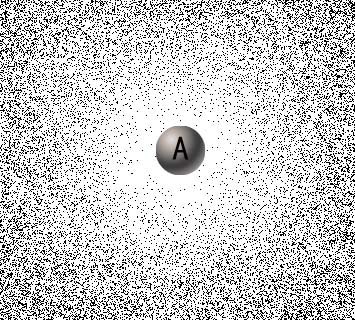
FIG. 2 Distribution of
Yizi gas around planet A
|
Where the
energy of Yizi gas is low, its density is high and the number of Yizi gas per
unit volume is large. The density of Yizi gas increases with the elevation, and
it creates a top-down buoyancy. The amount of buoyancy an object receives
depends only on the volume of the elementary particles that make up the object
to displace the Yizi gas. If the quality of basic particle density are the
same, then the buoyancy produced by the Yizi gas is related to the mass of the
elementary particles that make up the object. This is why both the feather and
the iron ball fell at the same time in the free fall experiment.
On
earth, the gravitational force of one object on another is not always positive,
but sometimes negative, meaning that one object repels another.When the
temperature of an object B is lower than its ambient temperature, the
distribution of the promoters around the object B is shown in figure 3: the
kinetic energy of the promoters around the object B is small and the density is
high, and then the object B has a repulsive effect on the object at the ambient
temperature.
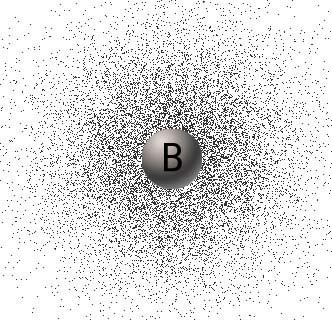
Fig.3
The distribution of Yizi gas around object B when the temperature of object
B is lower than the ambient temperature
|
You
may ask if the earth's gravity decreases in a freezing winter. The earth's
center temperature is very high, the radius of the earth is 6400 kilometers, and
the sun can only change the earth's surface temperature about 10 meters deep.10
meters below the temperature is generated by the earth itself, the temperature
is relatively constant, three feet of freezing is not enough to change the
gravity of the earth.
Gravity
can only exert a force within a certain distance. When an object is too far
away from a planet, the space where it is located will have the same density of
Yizi gas as the cosmic background temperature, and the force on the object will
become zero.
Someone
asked, if the temperature had such an effect on gravity, the rocket would have
been so hot that it would have been impossible to control it. Right? When two
objects attract each other, each changes the density of the Yizi gas around it,
and creates a gravitational field, the
corresponding constant acceleration of gravity, such as the surface of the
earth's gravitational acceleration g=9.8m/second2,and the gravitational
acceleration constant produced by the rocket probably be only 10-9-10-8m/second2,
negligible, that is to say, the contribution of earth and rocket to the
magnitude of gravitation is not the same. The earth generates an active
gravitational field.
Although
the density of Yizi gas around the stars increases with the altitude, however in
unit time, in any given radial direction of the planet, Yizi passes through a unit
area. The number of Yizi diffuses from the inside of the unit area to the
outside is equal to the number from the outside to the inside, both are n. Let Yizi’s outer-to-inner diffusion velocity be V1,
V2, V3, ... Vn, the inner-to-outer diffusion
velocity be V1', V2', V3', ... Vn',
the average velocity of Yizi outer-to-inner diffusion be, and the average velocity of Yizi inner-to-outer diffusion
be.Then

LetV be the velocity variance of Yizi
outer-to-inner diffusion, andV' be the velocity variance of Yizi
inner-to-outer diffusion.

The
irregularity of a star decreases as the radius increases.The closer to the
star, the greater the unevenness of the motion rate of Yizi is.So the
unevenness of the motion rate that diffuses from the inside to outside is
greater than that from the outside to inside, ie

Expand Equation 3 and Equation 4:

Substituting Equation 1 and 2 into Equation
6 and 7 respectively:

Substituting Equation 8 and 9 into Equation
5 respectively

According
to the law of conservation of energy,

Substituting Equation 11 into 10 gives: > ie

multiplying
both side of Equation 12 with ,we obtain

Since force is a change in momentum per unit time, the
force exerted by Yizi on this unit area:

3. The Light and Heat of the Sun is not
Generated by Fusion
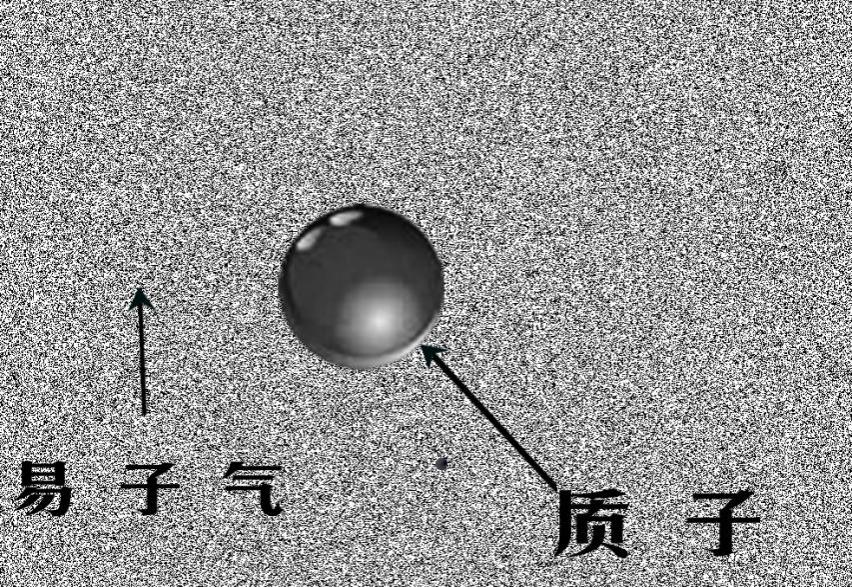
Fig.4 Protons
suspend in Yizi gas.
3.1. Our
universe is a mixture of protons, electrons and Yizi. Most protons and
electrons suspend in Yizi gas in different material forms, as shown in figure
4.When a single proton suspends in Yizi gas, since the volume of the proton is
much larger than Yizi, a proton collids with a large number of Yizi around it
at the same time. The cooperative force of Yizi on the proton tends to be
balanced, the kinetic energy of the proton is very small, and the temperature
tends to zero (cosmic background temperature). At the same moment, the number
of collisions of protons, in a certain line, in opposite two directions is n1 and n2 respectively, and set up n=|n1-n2|,
then the momentum of a proton tends to be equal to that of n Yizi:
M proton×v proton ≈ n×mYizi×VYizi ——
1
Because n1 and n2 tend to be the same, so the value of n is small,
And because: Mproton ≫ n mYizi
So: vproton ≪VYizi ——2
From 1×2, we get:
Mproton × vproton × vproton ≪ n×mYiziVYizi × VYizi
That is,×Mproton × vproton2 ≪× n × mYizi VYizi2 ——3
At this time, the energy of n Yizi is
much larger than the energy of a proton.That is to say, when a single proton
suspends in Yizi gas, the momentum of the proton tends to be equal to that of n
Yizi, while the kinetic energy of the proton is much less than that of n Yizi,
and the temperature of the proton tends to absolute zero, although the energies
of Yizi around the proton are very high.
3.2. And when the multiple protons
are completely separated from the Yizi gas, since there is Yizi gas on one side
of the proton and no Yizi gas on the other,that is to say n1=0,n2=n.The proton’s one side collides
with n2 Yizi at the same time, and the kinetic energy of n2 Yizi is much
greater than that of the individual proton suspends in the gas. As shown in Eq.3, so the proton will continuously absorb energy from the YiZi
gas, so that the kinetic energy of a proton tends to be equal to the kinetic
energy of n2 YIzi, and the pressure tends to be equal, as shown in figure 5:
Now×Mproton×vproton≈× n×mYizi VYizi 2 -------④
Because vproton ≪VYizi--------⑤
So ④÷⑤ get:M proton×vproton ≫nmYizi×VYizi- --------⑤
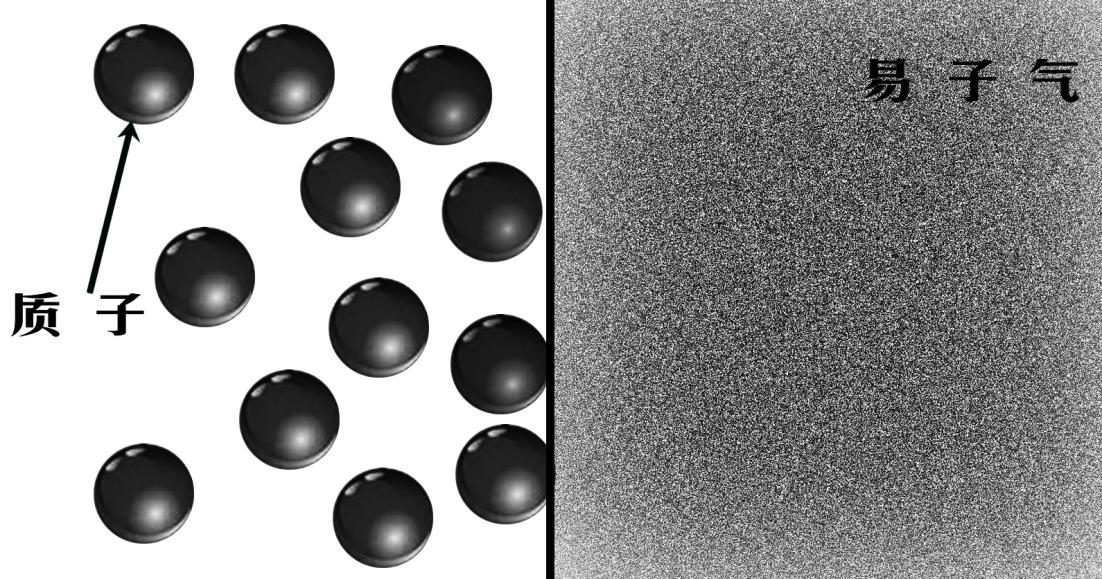
Fig.5 Proton gas and Yizi gas are distributed separately.
|
That is to
say, when multiple protons and commuton gas are completely separated, the
kinetic energy of a single proton tends to be equal to that of n commutons,
while the momentum of a single proton is far greater than that of n commutons.
The
greater the mass of the object, the less the Yizi gas that penetrates into the
interior of the object, and the greater the difference in the Yizi density of
the inner and outer parts of the object. More Yizis transfer kinetic energy to
the proton, and the temperature of the object is higher. The object absorbs
energy in the form of a direct collision and then releases the energy in the
form of thermal radiation to form a dynamic equilibrium.
4. Three physical experiments prove
the existence of Yizi
4.1. Experiment 1: The
gravitational interaction between two objects is not only related to the masses
of the two objects but also to the ambient temperature at which the two objects
are located. The force between the two objects is mutually exclusive when their
temperature is lower than the ambient temperature.
4.1.1. Experimental equipment and environment: The vacuum tank as shown
in Fig.6. the inner diameter is 1.8m and the inner height is 1.8m. It is placed
in a constant temperature cave. The gravitational torsion scale (Cavendish
torsion scale) is placed on a small table in the vacuum tank as shown in Fig.7.
The light is injected from the outside of the vacuum tank onto the small mirror
on the torsion scale, and reflected to the opposite side on the whiteboard.
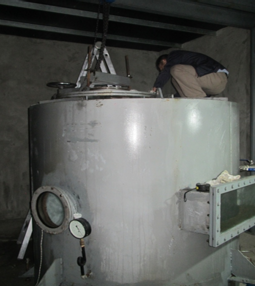
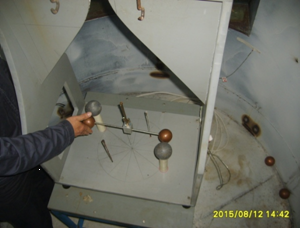
Fig.6 Vacuum tank with a torsion
scale placed in. Fig.7 A homemade Cavendish torsion scale placed in the vacuum tank.
|
4.1.2. Basic parameters and
principles of the experiment:
As shown in Fig.8 and Fig.9:
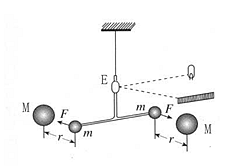
Fig.8 working principle diagram of
Cavendish torsion balance
|

Fig.9 vertical dimension of the
torsion balance
|
4.1.2.1. The size of
gravity F,
4.1.2.2. The distance of
the reflective plane mirror from the whiteboard L=10.3m
4.1.2.3. The small copper
ball mass m=0.575kg, the large lead ball mass M=1.5kg
4.1.2.4. Torsion balance
arm length d = 0.15m
4.1.2.5. The free vibration
period of the torsion balance is T=214s
4.1.2.6. S is the amount
of movement of the scale light spot
4.1.2.7. The distance
between the center of mass of the big ball and the small ball is r.
4.1.3. Matters need attention:
4.1.3.1. When the gravitation
torsion scale is placed in a vacuum tank with constant temperature, it does not
change the ambient temperature or the temperature of the metal ball, the big
metal ball and the small metal ball attract each other, because the temperature
of the metal ball is slightly higher than the temperature of the surrounding Yizi
gas.The larger the mass of an object in a constant vacuum, the higher its
central temperature will be. This will be proved in the following experiment.
4.1.3.2. The vacuum degree
of the vacuum tank should be less than 1000Pa. If there is too much residual
air, when the ambient temperature changes, the air around the large metal ball
and the small metal ball will turn over, affecting the experimental results.
4.1.3.3. There should be
no objects around the metal sphere other than the one used to measure gravity, otherwise
the experiment will be complicated and even lead to the opposite result.
4.1.3.4. Not all metals
are suitable for gravitational experiments. For example, metal aluminum has a repulsive
effect on metal lead itself, so neutral metals are more suitable for
gravitation experiments.
4.1.3.5. Slowly inject ice water or hot water to avoid the
obvious Thomson effect and increase the additional gravity, which will have a
great impact on the experiment.
4.1.4. Experimental steps:
4.1.4.1. Remove the two
large lead balls from the torsion scale, leaving only two small copper balls on
the T-frame of the torsion scale.
4.1.4.2. Vacuum the vacuum
tank with a vacuum degree below 1000Pa.
4.1.4.3. It will take 72
hours for the torsion scale to stop swinging in the vacuum. When the torsion
scale stops swinging, mark the position of the light spot on the white board
and draw a vertical line in red to represent the balance position.
4.1.4.4. Send hot air to
the insulating room to do basic test on the whole experimental system. There is
no obvious change in the point of light, so the influence of the system on it
can be ignored.
4.1.4.5. Turn off the air
conditioner, open the vacuum tank, put the big ball on the torsion scale, the
center distance between the big ball and the small ball is about 10CM, then
close the vacuum tank and vacuum it.
4.1.4.6. After standing in
the natural environment without heating or cooling for 72 hours, it was found that
the light spot shifted to the direction of attraction by about 0.4-0.5cm,
S≈0.0045m.
Gravitation
force in the natural state

4.1.4.7 At this time, sent
hot air to the insulating room. The temperature inside the room rises by 3 to 4
degrees in 3 minutes, and the temperature inside the vacuum tank rises less
than 0.1 degree. At this time, the temperatures of the big ball and the small
ball are lower than the environment in which they are located. The light spot
move 3.5CM in the direction in which the big ball and the small ball repel each
other. As the temperature in the room increases, the maximum moving distance of
the light spot to the repulsive direction is about 15CM, as shown in Fig.10.
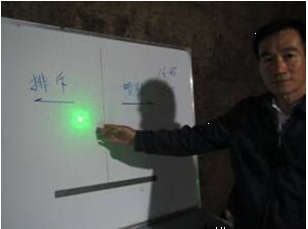
Fig.10 When external
temperature of the vacuum tank rised,the light spot moves in repulsive
direction
The repulsive force F which generated
by the light spot moving 15CM:

This repulsive force is 33 times the
gravitational force measured at the natural ambient temperature.
4.1.4.8. Turn off the air
conditioner and let the heat insulating room stand still.
After two days, send cold air to the
insulating room. As the temperature of the room decreases, the gravity between
the big ball and the small ball increases, and the light spot moves in the
direction of mutual attraction, and the maximum moving distance reaches 17CM.
This attractive force is 37 times of the gravity measured in the natural
environment temperature.
4.2. Experiment 2: Change the
temperature of the big metal ball on the gravitation torsion scale, the
temperature of the small metal ball is unchanged, observe the effect of the big
metal ball on the force of the small metal ball (when the temperature of the
big metal ball increases, it will attract the small ball; when the temperature
of the big metal ball decreases, it will repel the small ball).
4.2.1.
Laboratory equipment and environment: A constant temperature room built in a cave.
A vacuum tank, placed inside the constant temperature room, with a gravitational
torsion scale placed inside it. A hanging wire hang a T-frame on the torsion
scale, and at the two ends of the T-frame, there is a small copper ball
respectively, as shown in Fig.11. One of the small copper balls has a large hollow
copper ball on its side. The large copper ball has an inlet pipe and an outlet
pipe, which are used to change the temperature of the large copper ball by
injecting hot water or ice water into it through a miniature water pump, as
shown in Fig. 12.
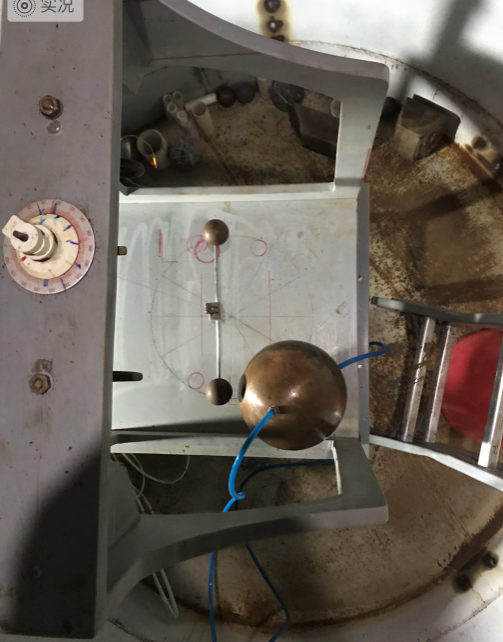

Fig.11
Top view of gravity balance in vacuum tank Fig.12 A small pump and a bucket
used to fill in the large hollow copper ball with hot or icy water.
4.2.2
Matters needing attention
4.2.2.1The
vacuum degree of the vacuum tank should be less than 1000Pa. If there is too
much residual air, when the ambient temperature changes, the air around the
large metal ball and the small metal ball will turn over, affecting the
experimental results.
4.2.2..2
There should be no objects around the metal sphere other than the one used to
measure gravity, which would complicate or even reverse the experiment.
4.2.2.3
The large hollow copper ball must be connected with the ground wire to avoid
electron transfer and electrostatic attraction inside the hollow copper ball
caused by injection of ice water or hot water.
4.2.3.
Experimental steps:
4.2.3.1. The
center of the large hollow copper ball placed on the torsion balance is on the
same horizontal plane as the center of the small copper ball on the t-frame, as
shown in Fig.13.
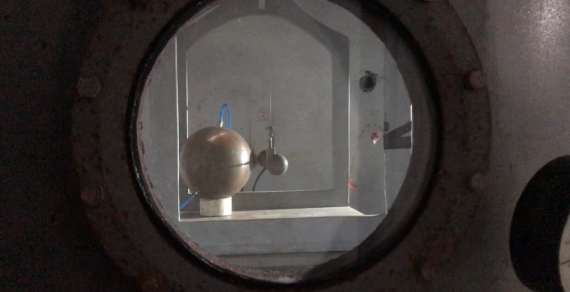
Fig.13 The
center of the large hollow copper ball is on the same level as the center
of the small copper ball
|
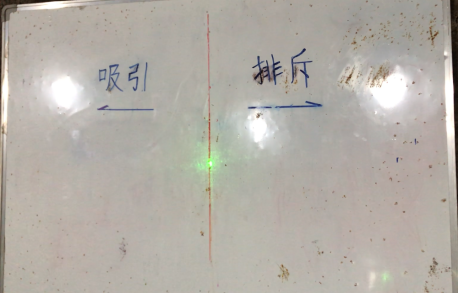
Fig.14 The small copper ball below the suspension
stops swinging and the light spot stays on the midline.
|
4.2.3.2. After being placed for a long time, the small copper ball under the
suspension wire has stopped swinging, and the light spot stays on the middle
line of the white board, as shown in Fig.14.
4.2.3.3.
When we inject hot water into the large hollow copper ball, it attracts the
small copper ball, and the light spot moves in the direction of attraction.
4.2.3.4.
When we inject ice water into the large hollow copper ball, it repels the small
copper ball, and the light spot moves in the direction of repelling.
4.3. Experiment 3: Under the condition of
constant temperature and vacuum, the temperature of an object is related to its
mass. The larger the mass of an object, the higher its temperature will be.
4.3.1.
Laboratory equipment and environment: a homothermal room built in the cave, a vacuum
tank placed in the homothermal room; a vacuum pump, a temperature collector and
computer are placed outside the room; a 1000kg copper ball and a 1.2kg copper
ball, both are placed in the vacuum tank as shown in Fig.15.
4.3.2. Matters need attention:
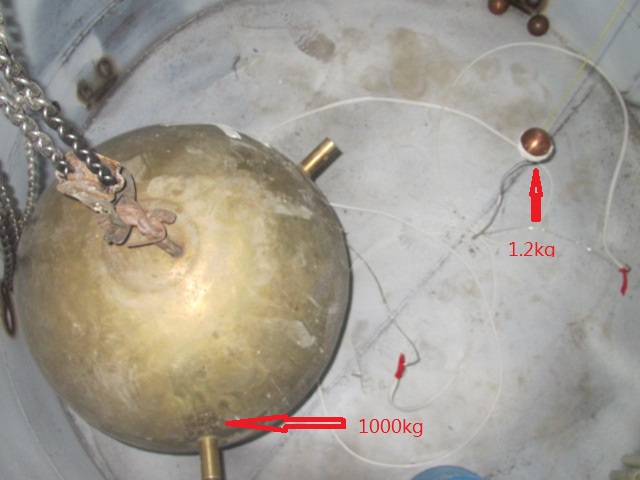
Fig.15 A 1000kg copper ball and a
1.2kg copper ball are suspended in a vacuum tank.
|
4.3.2.1. Thermistor [9] is very sensitive, and its temperature
measuring error is 0.002degree, so all electric lines must be welded, the main
circuit must use electrostatic shielding wire, and the joints shall be insulated.
4.3.2.2. Copper balls are used in this
experiment mainly because of the high thermal conductivity of copper. The
temperature reaches the equilibrium state quickly and its price is moderate.
There are three main ways of heat transfer: heat conduction, convection, and
heat radiation. Here, in order to maintain a constant temperature, we place the
large and the small copper ball in a vacuum tank, suspend them, and let them
balance the temperature mainly in the form of heat radiation. The center of the
large and the small copper balls should be on the same horizontal plane, which
mainly takes into account the inconsistency of the ambient temperature at
different horizontal planes.
4.3.2.3. The current flowing through
the thermistor should be as small as possible,otherwise, the current will
generate the same amount of heat. The small copper ball will be warmer than the
large copper ball, because it can not dissipate as much as the large ball. Here
the thermistor carries a current of 0.0104 mA.
4.3.2.4. The 24-hour temperature
change of the vacuum tank in the homothermal room shall not exceed 0.2 degrees.
4.3.3. Experimental steps:
4.3.3.1.
Place the large copper ball and the small copper ball in the vacuum tank and
keep their centers at the same level. The thermistor R1 attaches to surface of
the large copper ball, and the thermistor R2 attaches to surface of the small
copper ball.
4.3.3.2. Close the vacuum tank and
evacuate it to a vacuum of -0.1 MPa.
4.3.3.3. Because the copper balls have
been placed in the cave for a long time, the heat balance will not take too much
time, and 24 hours is enough. After 24 hours, the temperature curve shown in
Fig.16 is recorded by the thermistor collector and computer. The red line
indicates the temperature change curve of the large copper ball with time. The
blue line is the temperature change curve of the small copper ball with time.
The average temperature of the large copper ball is about T1=10.13, and the
average temperature of the small copper ball is about t1=10.04.
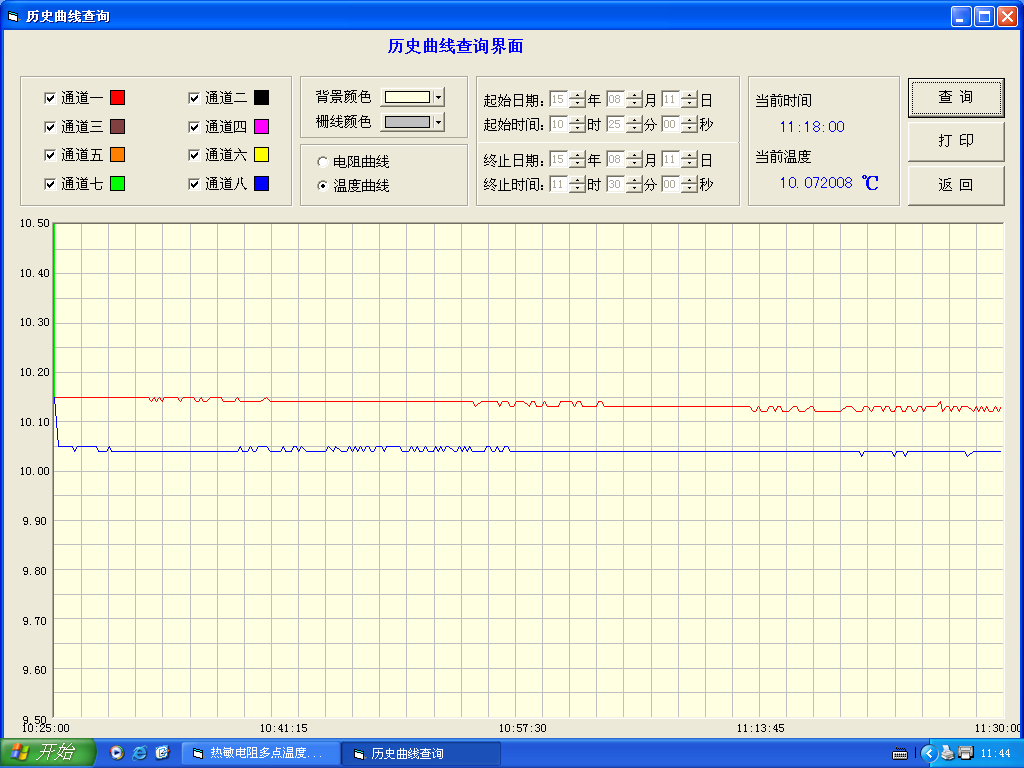
Fig.16 The temperature curve of the big copper ball
and the small copper ball over time. The red line represents the
temperature of the big copper ball and the blue line represents the small
copper ball.
|
4.3.3.4. Open the vacuum tank, reverse
the two resistances. Attach the resistor R1 to the surface of the small copper
ball, and measure its temperature. Attach the resistor R2 to the surface of the
large copper ball, and measure its temperature. Close the vacuum tank, vacuum,
and check the temperature record after 24 hours.
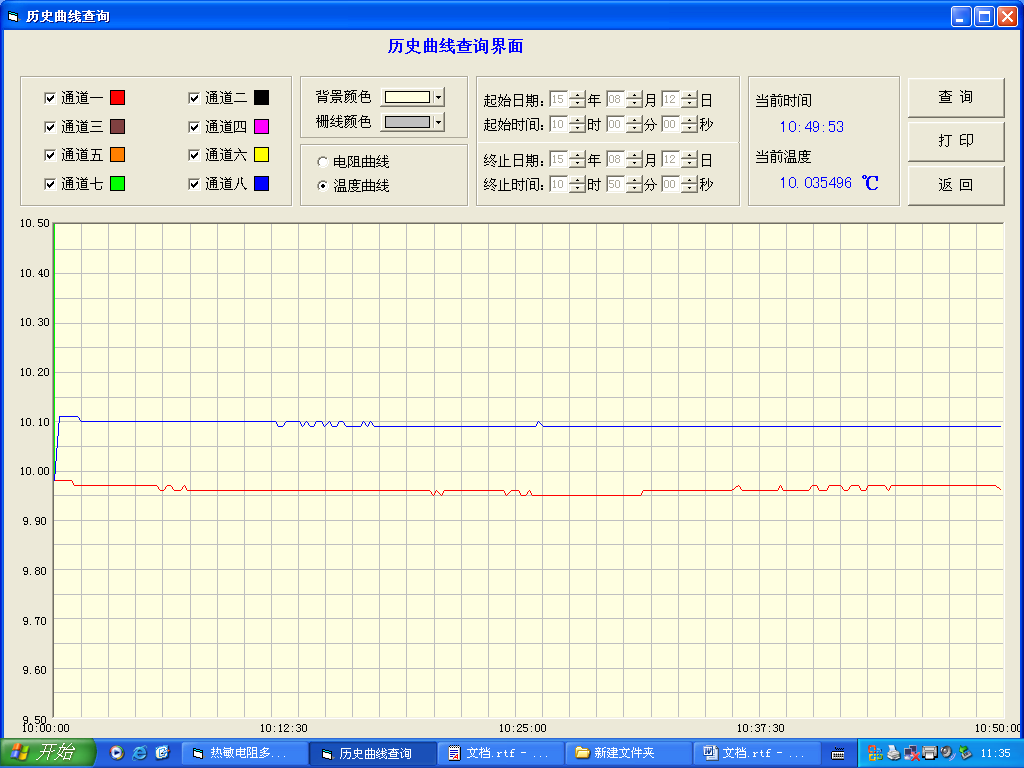
Fig.17 The temperature curve of the big copper ball
and the small copper ball over time. The blue line represents the
temperature of the big copper ball and the red line represents the small
copper ball.
|
4.3.3.5. After 24 hours, query the
computer, as shown in Fig.17; the blue curve shows the temperature curve of the
large copper ball change with time. The average temperature of the large copper
ball is about T2=10.07. The red line is the temperature curve of the small
copper ball change with time, and its average temperature is about t2 = 9.97.
The average temperature difference between the two balls measured twice.
The temperature of the large copper
ball of 1000 kg is 0.095 degrees higher than the small copper ball of 1.2 kg.
The two thermistors are swapped for
the purpose of eliminating system errors because the temperatures measured by
the two thermistors are erroneous at the same temperature.
The above experiments proved that
under constant temperature and vacuum conditions, the greater the mass of the
object, the higher the temperature of the object, and the greater the
gravitational force formed. Gravity can only exert force within a certain
distance. When an object is too far away from the planet, the force on the
object will become zero when the microwave in the space where the object is
located is the same as the microwave intensity generated by the Yizi gas at the
cosmic background temperature.
5.
The physical properties of Yizi
5.1. The trajectory of Yizi movement
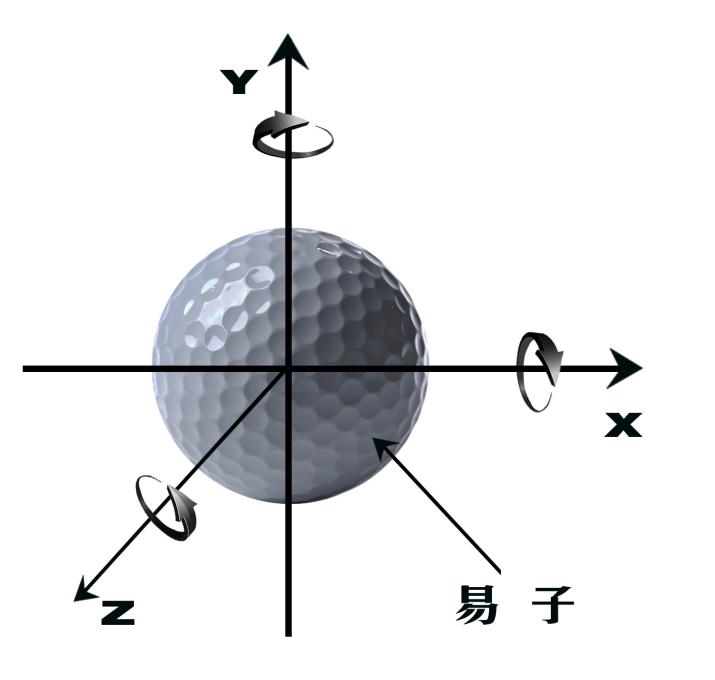
Fig.18
Yizi model
Assume that
the Yizi is a rough surface sphere, as shown in Fig.18. In addition to
translation, the movement of the Yizi also has an eccentric rotation motion of
the Yizi around the x-axis, the y-axis, and the z-axis. The eccentric rotation makes
the movement trajectory of the Yizi in each plane to be a circle. The circles
in three planes combin into a closed ellipse, so the trajectory of the Yizi is
a closed ellipse, instead of a straight line. The Yizi has not only a high
translational speed, but also a higher edge velocity when rotating.
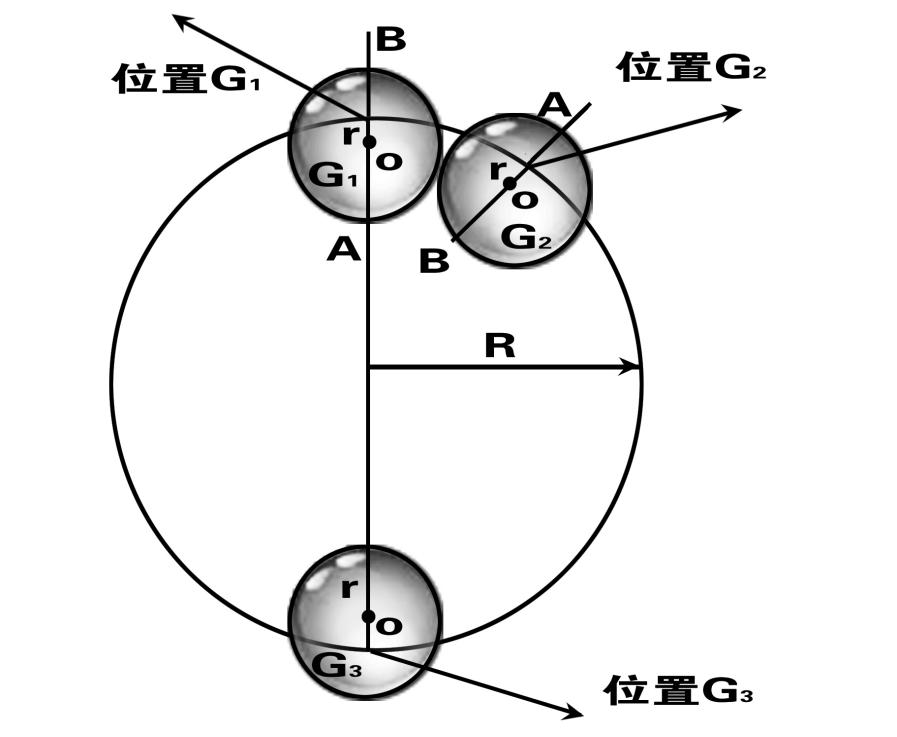
Fig.19 Plane movement trajectory of Yizi.
|
When Yizi
collide with each other, they transfer not only translational momentum,but also
angular momentum. The edge collision of Yizi makes it have a very high rotational
speed. As shown in Fig.19, suppose that Yizi moves in a circle. When Yizi is in
position G1, the angular momentum of A is greater than that of B.The commutator
rotates in half a circle and the angular momentum is transferred once, the
angular momentum at A is transferred to B, and B transfers angular momentum to
A.When Yizi moves to the position G2, it rotates n+1/2 times. At this time, the
angular momentum of the A end is converted to B, and the angular momentum of
the B end is converted to A. During this conversion between the A end and the B
end, the angular momentum of Yizi in the inner side of the large circle R is
always greater than the angular momentum outside the large circle. This inner
and outer angular momentum difference only changes the direction of motion, but it has no effect on the magnitude of the
inner and outer angular momentum. The eccentricity r and the radius R of the Yizir's
circular motion satisfy the following formula,
where V is the plane motion rate of the Yizi, R is the radius of
the circular motion of the Yizi eccentricity point, r is the eccentricity of
the Yizi rotation, and n is the number of rotation times of the Yizi
revolution.
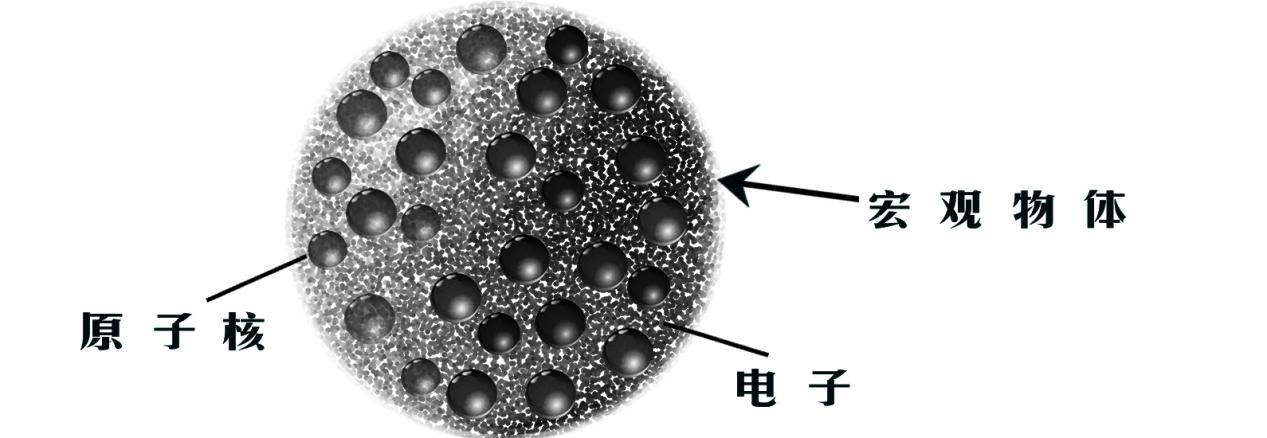
Fig.20 A macroscopic object composed of proton
electron commutons
|
The
same is true for electrons and protons. If the surface is rough and the
trajectory is a closed ellipse, it is not surprising that large angles of
scattering occur in collisions. There is no straight linear motion in the micro
world. Then why does the macro world have a linear motion? Since the
macroscopic objects are composed of many particles,as shown in
Fig.20, when the macroscopic object rotates, the particles in the object
collide with each other, and the angular momentum in the object is quickly
distributed uniformly, so that the object rotates around the centroid.
5.2. Average
Speed of Yizi
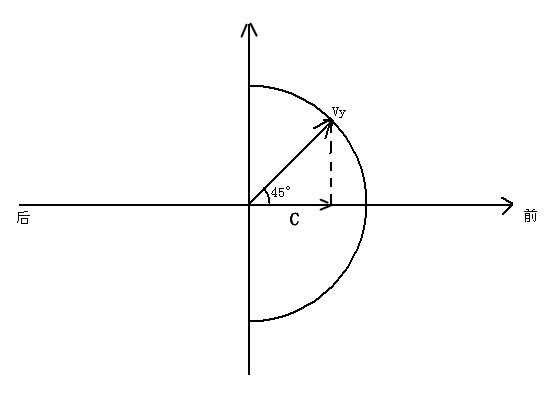
Fig.21 Schematic diagram of the relationship between
the average velocity of commutons and the speed of light.
Light is
transmitted by Yizi gas, just as sound is transmitted by air. The average speed
of Yizi's irregular movement in Yizi gas determines the speed of light
propagation in Yizi gas. The light will be like a sound, gradually weakening in
the spread, and eventually dissipate in Yizi gas. The speed of sound
propagation in the air is related to the rate of thermal motion of air
molecules. As the temperature increases, the rate of thermal motion of air
molecules increases and the speed of sound increases. Light is transmitted by
Yizi gas, and a large number of Yizi do irregular movements colliding with each
other. Unlike air molecules, air molecules do elastic collisions, while Yizi
does hard collisions, and there is no time of relaxation. The opportunity for
Yizi to move in all directions is equal. If the direction of movement of Yizi
is divided into two directions, the average direction of movement of the Yizi with
a tendency to move forward should be 45°angle in the forward direction, as shown in
Fig.21, where Vy is the average velocity of YiZi, C is the speed of light, and
the average propelled forward velocity C=Vy
, is the speed of light. The average speed of Yizi is Vy=c=
4.24 x 108m/sec.
5.3. The mass
of Yizi
We know the energy carried by electromagnetic wavesε=hγ[10], where h is the Planck constant and γ is the frequency of the electromagnetic wave. In fact, h is the
minimum average energy that electromagnetic waves can carry, that is, the
average kinetic energy carried by per Yizi, so h=myvy2, where my is
the mass of the Yizi.

References:
[1] Fundamental particles : Edited
by Cen yisheng and Lizengzhi University Physics Edited the second volume of
Tianjin university press 1999.2
[2] The interstellar cloud: Edited
by lee chongwei and Xiao xinghua Astrophysics,Beijing higher education press
2000
[3] Electron cyclotron: Edited
by Cen yisheng and Lizengzhi University Physics Edited the second volume of
Tianjin university press 1999.2
[4] Brownian motion: Edited
by Cen yisheng and Lizengzhi University Physics Edited the second volume of
Tianjin university press 1999.2
[5] Cosmic background
radiation of 2.735k: Edited by lee chongwei and Xiao xinghua
Astrophysics,Beijing higher education press 2000
[6] Planck's constant: Edited
by Cen yisheng and Lizengzhi University Physics Edited the second volume of
Tianjin university press 1999.2
[7] the speed at which light
travels: Edited by Cen yisheng and Lizengzhi University Physics Edited the
second volume of Tianjin university press 1999.2
[8] grand unified theory: Edited
by Zhangli Progress in modern physics,Beijing Tsinghua university press 1997
[9] thermistors: Edited
by Wang cu、Li chun and Zhou lezhu.Electromagnetics.Peking
university press 2000.2
[10]ε=hγ:
Edited by Jin zhonghui、Liang deyu,University basic physics.Beijing science
press,2000.5

